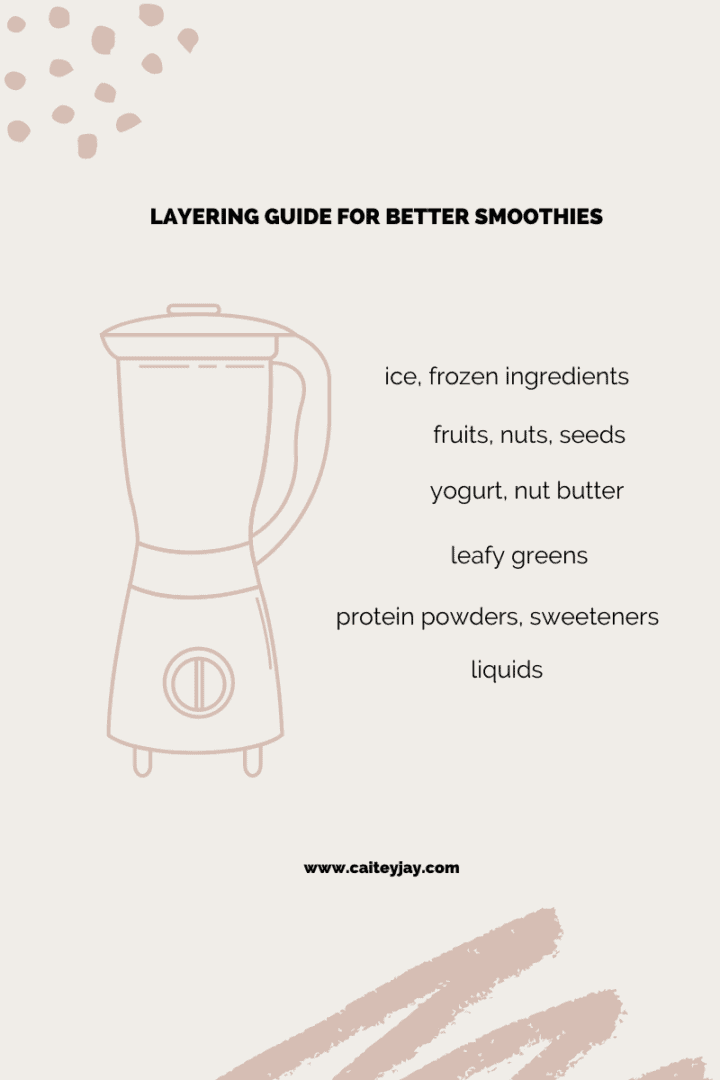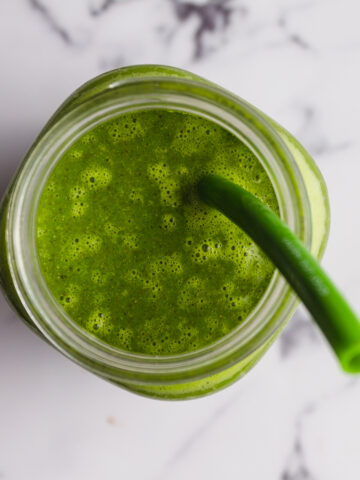Do you ever wonder why smoothies are so much better when you buy them? It's all about understanding how to build a smoothie. Avoid a gunky, chunky, funky shake with the tips and tricks below.

Jump to:
- Does the order of ingredients in your blender matter?
- What setting should I use on my blender?
- How to make a smoothie thinner
- How to make shakes thicker
- How to make the perfect smoothie bowl
- How to make weight gain smoothies
- What can I put in my smoothie for protein?
- Choosing a high quality protein powder
- What are the healthiest things to put in a smoothie?
- How to make a smoothie without yogurt or milk
- What should you put in a green smoothie to make it taste better?
- How to make a smoothie without a blender
- Video
- Healthy smoothie recipes
- Equipment
- Related Posts
Does the order of ingredients in your blender matter?
In a word: yes. A delicious smoothie starts with how you layer the ingredients in the blender.
That's because your layering technique affects how the smoothie processes and ultimately the texture of the drink. Combining smoothie ingredients in the wrong order is a sure way to get frozen ingredients stuck in your blender blades.
So, what's the right way to load your blender?
It's all about pairing ingredients together based on their consistency and then adding them in the right order. It's best to start with liquids at the bottom and finish with frozen ingredient at the top.
Be sure to print or pin the layering guide below for reference when you make your next smoothie.

Note: Too many frozen ingredients may be another reason your blender stalls; use a mix of fresh and frozen ingredients to ensure a smooth blend.
What setting should I use on my blender?
Blend on high. According to Vitamix, whether you're making shakes, soups, or even thick spreads, you'll get the best results by starting your blender on low and quickly ramping it up to high.
This not only reduces the recipe time, but is also better for your blender, keeping the motor cool. That's a win in my books because good blenders ain't cheap.
How to make a smoothie thinner
I'm all about creamy, thicc smoothies. But, I have my limits. If you do too, here's how to make a smoothie less thick: add liquid.
Good options include: water, dairy milk, non-dairy milk and juice (just be sure it's not filled with added sugars).
Add a little bit of your liquid of choice and blend for 30 seconds at the highest speed. Repeat this process until your desired consistency is reached.
How to make shakes thicker
No one likes a watered down smoothie. Or maybe they do? I'm not sure. But, if you're team extra creamy, here's how to make smoothies thick and creamy.
The trick is to add a thickening agent.
Some good options include: frozen vegetables (cauliflower), frozen fruit (bananas, avocados), nut butters, tahini, yogurt, pumpkin puree, oatmeal, coconut oil, butternut squash and sweet potatoes.
Freezing your liquid ahead of time is another way to thicken the consistency of your shake. Think about it this way... ice will thicken a smoothie more than water. So will frozen almond milk.
Add a little bit of your thickening agent of choice and blend for 30 seconds at the highest speed. Repeat this process until your desired consistency is reached.

How to make the perfect smoothie bowl
The key - don't stop blending too soon.
I get it, we're all in a rush. But, good things take patience.
Be sure to leave your blender running for at least 15 seconds after it appears that everything has been liquified. This extra processing time will break up any small chunks that would have ruined your smoothie bowl.
PS - this applies to shakes too!

How to make weight gain smoothies
Maybe you struggle to put weight on. Maybe you're in bulking season. Whatever your motive is for gaining weight, know that protein shakes can be an easy way to rack up calories in a healthy way.
The best way to increase the calorie count in a smoothie is to add protein and healthy fats. These are nutrient-dense options that also add major flavour.
For inspiration, check out the section below for a list of protein-including ingredients that will increase the calorie count in your shake. The majority of these are high in healthy fats too.
If you're feeling overwhelmed, don't even worry. I got you. I put together a chocolate weight gain shake for you to try.

What can I put in my smoothie for protein?
So, you want your smoothie to pack a punch of protein? I get it.
In fact, I think it's vital to add protein to your shake to support blood sugar balance. If you geek out on the data like me, here's why:
- Smoothies generally include fruit, which has a high amount of natural sugar. On its own, this fruit is absorbed quickly in the bloodstream and can "spike" your blood sugar.
- Protein, fibre and fat will help slow down the digestion of this fruit, ultimately slowing down the release of glucose into your bloodstream.
- It's a good thing to avoid a blood sugar swing. Frequent cycling between high and low blood glucose levels can lead to long term health problems.
- Furthermore, protein keeps you full for longer than carbohydrates. This will help minimize cravings for sweet and salty snacks shortly after you sip.
Now that you understand why protein is important. Let's talk about how to increase the protein content in your shake.
I like protein powder. But, I don't like it all the time. Afterall, it is a processed ingredient and I prefer to get my nutrients from whole sources when I can.
The good news is that there are countless other whole foods that you can add to your blender to up the protein content. Check out the list below for inspiration.
- Yogurt - plain yogurt, greek yogurt, kefir
- Seeds - pumpkin, flax, sunflower, chia, sesame
- Nut butter - almond, peanut butter, cashew butter, walnut butter
- Nuts - walnuts, pistachios, cashews, etc.
- Cheese - cottage, ricotta
- Grains - oats, quinoa
- Legumes - beans, peas (or pea protein powder), lentils, edamame, tofu
- Vegetables - avocado, sweet potato, cauliflower, spinach, spirulina, kale, broccoli

Choosing a high quality protein powder
If you decide to use protein powder to increase the protein content in your shakes, it's very important that you use a high quality option. The truth is, not all protein powders are created equal. In fact, many protein powders include a long list of ingredient names that you can’t pronounce.
To make things a little easier for you, I put together a list of things I look for in a high quality protein powder:
- No added sugars or artificial sweeteners - ensure it's sweetened naturally
- From grass fed cows, not treated with pesticides or hormones
- Cold processed - made with great care to reduce exposure to harsh temperatures that can alter and denature protein
- Highly digestible—look for medium chain fatty acids (MCTs), not long chain fatty acids
- Added enzymes - to help with digestion and absorption
Have a read and be sure you follow these guidelines when you're shopping for your next bucket.
If you want to learn more, Precision Nutrition has an in-depth guide on protein powder selection I recommend checking out.
What are the healthiest things to put in a smoothie?
If you're feeling creative and want to come up with your own healthy smoothie, here are some ingredients you should consider adding to supercharge your shake.
- Dark leafy greens
- Cruciferous vegetables
- Frozen fruits
- Nuts and seeds
- Yogurts and nut milks
- Supplements like spirulina and collagen powder
If you want a made-for-you option that's full of healthy add-ins, check out my Sour Apple Smoothie.

How to make a smoothie without yogurt or milk
Maybe you’re lactose intolerant. Maybe you’re avoiding dairy. Whatever the reason, you can make a creamy, delicious dairy-free smoothie. I promise.
For starters, almost everything I listed in the "how to thicken a smoothie" section applies. As a reminder, that list included: frozen vegetables (cauliflower), frozen fruit (bananas, avocados), nut butters, tahini, pumpkin puree, oatmeal, coconut oil, butternut squash and sweet potatoes.
Some of my other favourite dairy-free protein shake add-ins are:
- Coconut cream
- Almond milk yogurt or coconut yogurt
- Chia seeds
- Plant-based protein powders
If you want a full understanding of how to swap in alternatives for yogurt, check out my post here. And, if you're not in the mood to recipe test, go ahead and make my anti-inflammatory turmeric green smoothie. It's dairy-free and delicious.
What should you put in a green smoothie to make it taste better?
So, you have a sweet tooth? Same. Luckily, there are plenty of nutritious and delicious ingredients that you can add to a smoothie recipe to make it suit your taste buds.
My favourite add in is frozen bananas. They sweeten the smoothie and give it a thicker, creamier consistency. On top of that, bananas are packed with nutrients. This delicious fruit is high in potassium, which helps you regulate fluid balance, muscle contractions and nerve signals. It's also high in fibre, which helps keep you regular.
Another great option is Medjool dates. Many sweet ingredients are low in nutritional value. That's not the case here. Dates have high fibre content, which helps you stay full for longer, which ultimately helps you manage your weight. They're also high in antioxidants.
If you don't have a sweet tooth, no fear. There are other ways to add flavour to your green juice. Instead of sweet, you can go for spicy. Ginger is a great option because it not only adds a kick, but it's also a key player on the anti inflammatory foods list.
Let me know in the comments below if you have other favourite flavour blasters. I'm always looking for new ideas.
PS: My chocolate banana smoothie is crazy healthy, and literally tastes like dessert. You're welcome.

How to make a smoothie without a blender
I'll be honest... it won't be as good as a blender-made shake. But, it can be done. Here's how.
- Grab a plastic shaker (like a blender bottle) or glass jar (like a mason jar).
- Add milk and protein powder.
- Seal and shake for roughly 30 seconds until the mixture is smooth.
Note: you can add other soft ingredients. Just be sure to go for things that will mix easily without the need to be broken down. Think: cocoa powder, maca powder, collagen powder, acai powder, and even a thinner yogurt.
Video
Want to see how I make a smoothie? Watch the video below! This is my easy, healthy, tasty anti-inflammatory green smoothie.
Healthy smoothie recipes
Now that you know how to make the perfect smoothie, I invite you to check out my collection of healthy smoothie recipes.
Equipment
Here's what you need to make this recipe.
- Vitamix or any blender of your choice. I use the Vitamix Explorian now because it has an incredible processing speed that cuts down the time I spend blending. But, I used a Ninja blender successfully for years before upgrading.
- Mason jars or blender bottles for smoothie storage. If you're taking your smoothie on-the-go, the thermos blender bottle is a good option that will keep it cold all day long. I love using mine on road trips.
A note on blender selection:
- Size: consider your storage space and how many servings you'll be making
- Power: 500 watts is more than enough for smoothie making
- Settings: 3-10 speed settings gives you best control
- Extra features: The pulse button comes in super handy, get it if you can
- Good brands: Vitamix and Ninja are my favourite
Related Posts
If you enjoyed this post, check out these other cooking how-tos & techniques.
Please let me know if you have any other tips for building the perfect smoothie! I love hearing from you.










Leave a comment!